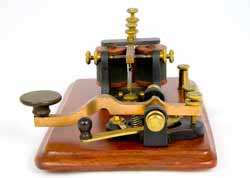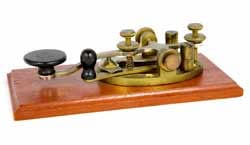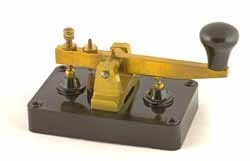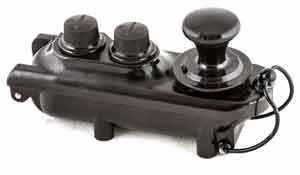Morse Code Facts: first Morse code message, etc
Interesting facts and figures about the Morse code system used for telegraphic communications - everything from the content of the first message sent in Morse code to the date of the last telegraph lines.
Morse Telegraph History Includes:
Morse telegraph history
Morse keys development
Vibroplex & mechanical bug keys
Telegraph sounder
Morse inker
Samuel Morse
Fascinating facts
Morse code SOS message
Morse keys:
Clipsal key
Camelback
Walters Electrical Patt 1056A Post Office key
Steel lever Morse telegraph key
RAF Bathtub Morse key
Samson ETM-5C electronic keyer
The Morse code was in use for many years, and provided an essential means of communication.
Some people have even called it the Victorian Internet because it enabled world-wide communications in a way never before possible.
Video: The Surprising History of the Morse Code & Morse Telegraph
Along with this it was used to send many historic and interesting messages.
Some interesting Morse code facts and figures have been assembled below.

These Morse code facts and figures have been split into a number of different sections.
Samuel Morse Facts
Details about Samuel Morse the inventor of the Morse code.
| Samuel Morse Facts | |
|---|---|
| Morse Code Fact | Details |
| Inventor | Samuel Finley Breese Morse |
| Birth date | 27 April 1791 |
| Date of death | 2 April 1872 |
| Age at death | 81 |
| Father | Reverend Jedidiah Morse |
| Place of Birth | Charlestown, Massachusetts, U.S.A. |
| Place of Death | New York City, U.S.A. |
| Career | Artist & inventor (He was one of the USA's foremost portrait painters) |
| First wife | Lucretia Pickering Walker (married 29 September 1818, died 7 February 1825 at the age of 25 in New Haven, New Haven, Connecticut). |
| Second wife | Sarah Elizabeth Griswold (married 1848) |
| Children | Cornelia Morse, Susan Morse, James Morse, Charles Morse, Edward Morse, William Morse, Samuel Morse. |

This one was manufactured around 1920 but it follows the basic design introduced by James Bunnell in 1881.
Facts about First Morse Code Message
Key details about the first message sent in Morse code and other details about the first Morse code telegraph.
| Facts about First Morse Code Message | |
|---|---|
| Morse Code Fact | Details |
| Date of first message. | 24 May 1844 |
| What was the first message sent in Morse code | "What hath God Wrought" |
| Why was this first message in Morse code chosen? | The message was taken from the Bible: Numbers 23:23, and it wasrecorded on a paper tape. It had been suggested to Morse by Annie Ellworth, the young daughter of a friend. |
| First message end points. | Washington and Baltimore. |
| Distance over which message sent. | ~40 miles |
| Funding for first telegraph line. | $30 000 from US Congress. |

Morse Code Speed Facts
Detaisl about records in sending Morse code.
| Morse Code Speed Facts | |
|---|---|
| Morse Code Fact | Details |
| Fastest speed | 6 May 2003 Andrei Bindasov from Belarus successfully transmitted 216 Morse code marks of mixed text in one minute |
| Fastest using a straight key | Achieved in 1942 by Harry Turner (Radio ham W9YZE) who reached 35 wpm in a demonstration at a U.S. Army base. |
| Fastest receiving / copying speed | July 1939 in Asheville, North Carolina, USA Ted R. McElroy set a for Morse copying, 75.2 wpm which is said to be still standing although some say others have exceeding this figure. |
It should be noted that speed records are being broken all the time, and the fastest ever recorded speeds may increase from time to time.

Morse Code Distress Signal Facts
Morse code was often used for sending distress signals - details about these messages.
| Morse Code Distress Signal Facts | |
|---|---|
| Morse Code Fact | Details |
| First distress signal | The first distress signal was "CQD" implying a general call to all stations indicating distress. This was first from 1904. |
| Distress signal | The letters "SOS" became the standard distress signal from around 1908 at the International Conference on Morse Code |
| SOS distress signal | The internationally recognized distress signal, SOS, does not stand for any words: the letters were chosen because they are easy to transmit in Morse code: "S" is three dots, and "O" is three dashes and they were easy remember and send. |

European keys often tended to be heavier than their US counterparts. This British Post office key dates from around 1900 and was manufactured by Walters Electrical.
Morse Code Key Dates
Key dates in the history of the Morse code and Morse telegraph.
| Morse Code Key Dates | |
|---|---|
| Morse Code Fact | Details |
| 1832 | Idea for telegraph first conceived. |
| 1838 | First message sent using dots and dashes to represent characters. |
| 1844 | American Morse code in final form. |
| 1844 | Washington to Baltimore line completed and first message sent. |
| 1850 | Sound reading generally replaces tape registers for receiving. |
| 1851 | International Morse code adopted in preference to the original American Morse code. |
| 1851 | Telegraph first used in train despatching. |
| 1858 | First transatlantic cable laid. It failed after 24 days. |
| 1860 | Automatic repeaters first used to entend the length over which telegraph lines could operate. |
| 1866 | Successful completion of transatlantic cable. |
| 1872 | Development of Stearns duplex system enables two messages to be transmitted simultaneously over one line. |
| 1930 | Last Morse wire closed by Associated Press. |
| 1989 | Western Union Telegraph Co dissolved. |
| 31 Dec 1999 | Morse code no longer required for International Distress signals. |
| 14 July 2013 | India's state-owned telecom company, BSNL, ended its telegraph service. This was reported to be the World's last true commercial electric telegraph system. |
Morse code today
It is an interesting fact to note that Morse code is still widely used today. It is mainly radio hams who use the Morse, or CW as it is often called. Also some Morse telegraph enthusiasts also use it.
Note on Morse Usage Today:
The Morse code or CW as it is often called is still widely used by radio amateurs where it is still able to provide a very effective mode of communication.
Read more about Morse usage today.
Although Morse proficiency is no longer required as a pre-requisite for a ham radio licence, many still prefer to use it as it allows communication over long distances with simple equipment and lower power levels.
In view of this, Morse code is likely to remain in use in some niche areas of radio communication for many years to come.
Video: Morse Code Practice
 Written by Ian Poole .
Written by Ian Poole .
Experienced electronics engineer and author.
More History:
Radio history timeline
History of the radio
Ham radio history
Coherer
Crystal radio
Magnetic detector
Spark transmitter
Morse telegraph
Valve / tube history
PN junction diode invention
Transistor
Integrated circuit
Quartz crystals
Classic radios
Mobile telecoms history
Vintage mobile phones
Return to History menu . . .


